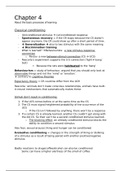Samenvatting
Summary Chapter 8 Psychology Peter Gray & David Bjorklund (7th edition)
- Instelling
- Universiteit Van Amsterdam (UvA)
- Boek
- Psychology
These are four chapters of the book 'Psychology' by Peter Gray This summary includes chapter 1,2,3 and 8
[Meer zien]





